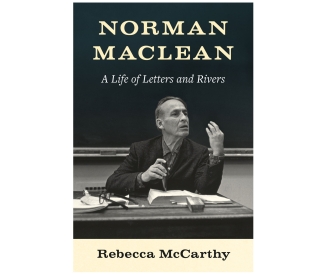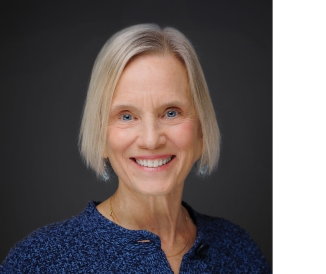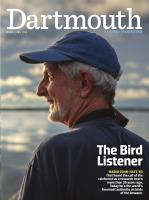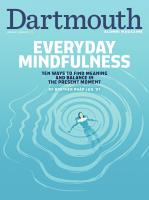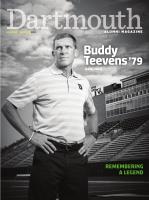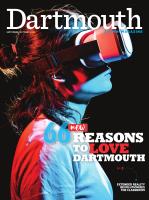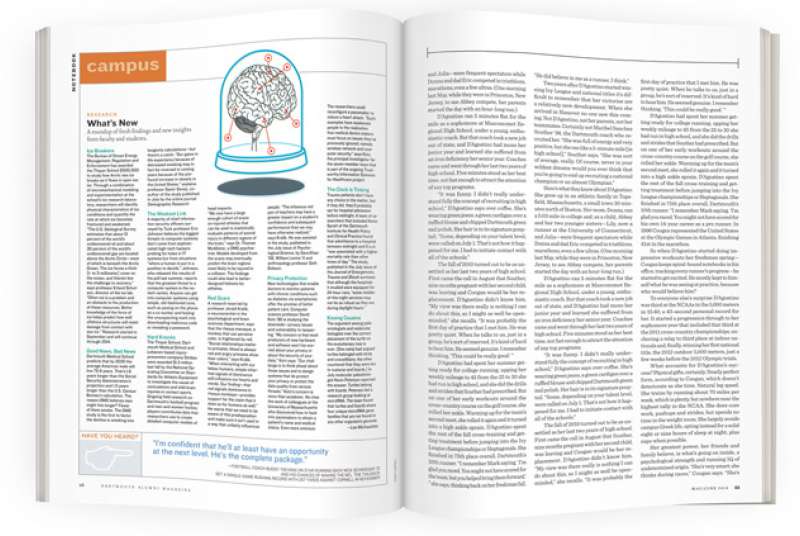
What’s New
Ice Breakers
The Bureau of Ocean Energy Management, Regulation and Enforcement has awarded the Thayer School $500,000 to study how Arctic sea ice breaks as it flows in open water. Through a combination of micromechanical modeling and experimentation at the school’s ice research laboratory, researchers will identify physical characteristics of ice conditions and quantify the rate at which ice becomes fractured and weakened. “The U.S. Geological Survey estimates that about 13 percent of the world’s undiscovered oil and about 30 percent of the world’s undiscovered gas are located above the Arctic Circle—most of which is beneath the Arctic Ocean. The ice forms a thick [1- to 3-millimeter] cover on the ocean, and therein lies the challenge to recovery,” says professor Erland Schulson, director of the ice lab. “Often ice is a problem and an obstacle to the production of these resources. Better knowledge of the force of ice helps predict how well offshore structures will resist damage from contact with sea ice.” Research started in September and will continue through 2014. LINK
Good News, Bad News
Dartmouth Medical School predicts that by 2030 the average American male will live 79.9 years. That’s 1.8 years longer than the Social Security Administration’s projection and 1.5 years longer than the U.S. Census Bureau’s calculation. The reason DMS believes men might live longer? Fewer of them smoke. The DMS study is the first to factor the decline in smoking into longevity calculations—but there’s a catch. “Our gains in life expectancy because of decreased smoking may in fact be reversed in coming years because of the profound increase in obesity in the United States,” explains professor Samir Soneji, coauthor of the study published in July by the online journal Demographic Research. LINK
The Weakest Link
A majority of chief information security officers surveyed by Tuck professor Eric Johnson believes the biggest threats to computer systems don’t come from sophisticated high-tech hackers probing for holes in IT systems but from situations “where a human is put in a position to decide.” Johnson, who released the results of his poll last summer, reports that the greatest threat to a computer system is the no-tech variety. Anyone can get into computer systems using simple, old-fashioned cons, such as posing on the phone as a co-worker and fooling the unsuspecting mark into downloading malicious code or revealing a password. LINK
Hard Knocks
The Thayer School, Dartmouth Medical School and Lebanon-based injury-prevention company Simbex were awarded $1.3 million last fall by the National Operating Committee on Standards for Athletic Equipment to investigate the cause of concussions and mild brain injuries in contact sports. Ongoing field research on Dartmouth’s football program and men and women hockey players contributes data that researchers use to create detailed computer models of head impacts. “We now have a large enough cohort of scans on injured athletes that can be used to statistically evaluate patterns of axonal injury in different regions of the brain,” says Dr. Thomas McAllister, a DMS psychiatrist. Models developed from the scans may eventually predict the brain regions most likely to be injured in a collision. The findings could also lead to better-designed helmets for athletes. LINK
Red Scare
A research team led by professor Jerald Kralik, a neuroscientist in the psychological and brain sciences department, says that the rhesus macaque, a monkey that can perceive color, is frightened by red. “Social relationships matter to primates, blood is always red and angry primates show their colors,” says Kralik. “When interacting with our fellow humans, simple inherited signals of dominance still influence our hearts and minds. Our finding—that red signals dominance in rhesus monkeys—provides support for the claim that it does so for humans as well.” He warns that we need to be aware of this predisposition and make sure it isn’t used in a way that unfairly influences people. “The infamous red pen of teachers may have a greater impact on a student’s confidence and subsequent performance than we may have otherwise realized,” says Kralik. He was assisted in the study, published in the July issue of Psychological Science, by Sara Khan ’08, William Levine ’11 and anthropology professor Seth Dobson. LINK
Privacy Protection
New technologies that enable doctors to monitor patients with chronic conditions such as diabetes via smartphones offer the promise of better patient care. Computer science professor David Kotz ’86 is studying the downside—privacy issues and vulnerability to tampering. “My concern is that most producers of new hardware and software won’t be worried about your privacy or about the security of your data,” Kotz says. “Our challenge is to think ahead about those issues and to design systems that do protect your privacy or protect the data quality from various threats.” Kotz’s concern is more than academic. He cites the work of colleagues at the University of Massachusetts who discovered how to hack into pacemakers to obtain a patient’s name and medical status. Even more ominous: The researchers could reconfigure a pacemaker to induce a heart attack. “Such examples have awakened people to the realization that medical device makers must focus on issues they’ve previously ignored, namely wireless network and computer security,” says Kotz, the principal investigator for the seven-member team that is part of the ongoing Trustworthy Information Systems for Healthcare project. LINK
The Clock is Ticking
Trauma patients don’t have any choice in the matter, but if they did, they’d probably opt for hospital admission before midnight. A team of researchers that included Kevin Spratt of the Dartmouth Institute for Health Policy and Clinical Practice found that admittance to a hospital between midnight and 6 a.m. “was associated with a higher mortality rate than other times of day.” The study, published in the July issue of the Journal of Emergencies, Trauma and Shock, surmises that although the hospitals it studied were equipped for 24-hour care, “some middle-of-the-night services may not be as robust as they are during daylight hours.” LINK
Kissing Cousins
The argument among paleontologists and molecular biologists over the correct placement of the turtle on the evolutionary tree is over. (One camp had argued turtles belonged with birds and crocodilians; the other countered that they were kin to tuataras and lizards.) In July molecular paleobiologist Kevin Peterson reported the answer: Turtles belong with lizards. Peterson led a research group looking at microRNA. The team found that turtles and lizards share four unique microRNA gene families that are not found in any other organism’s genome. LINK

